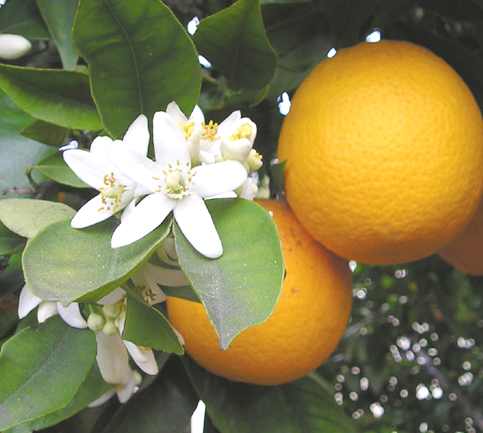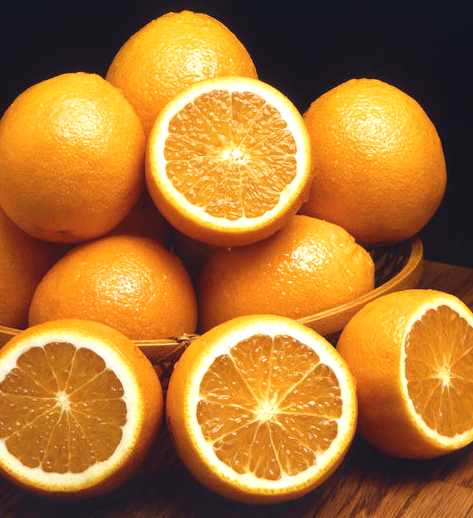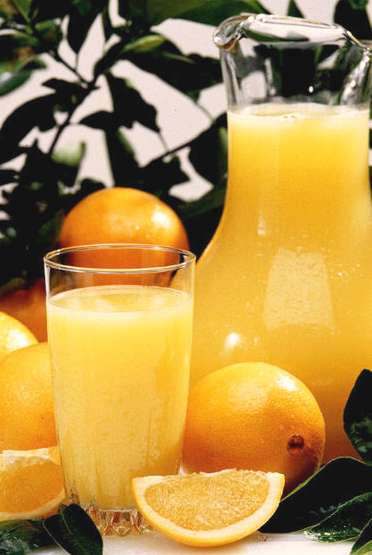|
ORANGES
|
||||||||||||||||||||||||||||||||||||
|
HOME | BIOLOGY | FILMS | GEOGRAPHY | HISTORY | INDEX | MUSIC | SOLAR BOATS | SPORT | SPONSORS |
||||||||||||||||||||||||||||||||||||
|
Orange—specifically, sweet orange—refers to the citrus tree Citrus sinensis and its fruit. The orange is a hybrid of ancient cultivated origin, possibly between pomelo (Citrus maxima) and tangerine (Citrus reticulata). It is a small tree, growing to about 10 m tall, with thorny shoots and evergreen leaves 4-10 cm long. The word "orange" comes from Sanskrit "narang". Oranges originated in southeast Asia, in either India, Pakistan, Vietnam or southern China. The fruit of Citrus sinensis is called sweet orange to distinguish it from Citrus aurantium, the bitter orange. In several languages it is known as Chinese apple (example: Dutch: Sinaasappel (China's apple)).
Orange flowers or blossom
Cultivation and uses
Orange cultivation is a major business and an important part of the economies of the US (Florida and California), most Mediterranean countries, Brazil, Mexico, Pakistan, China, India, Iran, Egypt, Turkey and to a lesser extent Spain, Portugal, South Africa, and Greece.
Tree Characteristics
Seed type: Angiosperm Leaf shape: Ovate shape with crenulate margins Leaf position: Alternate Type of fruit: Hesperidium
Production
According to FAOSTAT, the top producers of oranges (tonnes) in 2005 were:
Juice and other products
Oranges are widely grown in warm climates worldwide, and the flavors of orange vary from sweet to sour. The fruit is commonly peeled and eaten fresh, or squeezed for its juice. It has a thick bitter rind that is usually discarded, but can be processed into animal feed by removing water using pressure and heat. It is also used in certain recipes as flavoring or a garnish. The outer-most layer of the rind is grated or thinly veneered with a tool called a zester, to produce orange zest, popular in cooking because it has a flavor similar to the fleshy inner part of the orange. The white part of the rind, called the pericarp or pith, is a source of pectin.
'Ambersweet' oranges
Products made from oranges include:
Since oranges are susceptible to frost damage, growers commonly use sprinklers to coat them with ice when temperatures go below freezing. This practice protects the crops by regulating temperature.
Fruit
All citrus trees are of the single genus Citrus, and remain largely interbreedable; that is, there is only one "superspecies" which includes lemons, limes and oranges. Nevertheless, names have been given to the various members of the citrus family, oranges often being referred to as Citrus sinensis and Citrus aurantium. All members of the genus Citrus are considered beries because they have many seeds, are fleshy, soft and derive from a single ovary.
The Persian orange, grown widely in southern Europe after its introduction to Italy in the 11th c., was bitter. Sweet oranges were brought to Europe in the 15th c. from India by Portuguese traders, quickly displaced the bitter, and are now the most common variety of orange cultivated. The sweet orange will grow to different sizes and colors according to local conditions, most commonly with ten carpels, or segments, inside.
Portuguese, Spanish, Arab, and Dutch sailors planted citrus trees along trade routes to prevent scurvy. On his second voyage in 1493, Christopher Columbus brought the seeds of oranges, lemons and citrons to Haiti and the Caribbean. They were introduced in Florida (along with lemons) in 1513 by Spanish explorer Juan Ponce de Leon, and were introduced to Hawaii in 1792.
A single mutation in 1820 in an orchard of sweet oranges planted at a monastery in Brazil led to the navel orange, also known as the Washington, Riverside or Bahia navel. A single cutting of the original was then transplanted to Riverside, California in 1870, creating a new market worldwide. The mutation causes a 'twin' fruit, with a smaller orange embedded in the outer fruit opposite the stem. From the outside, the smaller, undeveloped twin leaves a formation at the top of the fruit, looking similar to the human navel. Navel oranges are almost always seedless, and tend to be larger than other sweet oranges. They are produced without pollination, through parthenocarpy.
Oranges and orange juice
The Valencia or Murcia orange is one of the sweet oranges used for juice extraction. It is a late-season fruit, and therefore a popular variety when the navel oranges are out of season. For this reason and to be one of the venues of the 1982 FIFA World Cup the orange was chosen to be the official mascot called "Naranjito" ("little orange") wearing the colours of the Spain soccer team uniform.
The blood orange has streaks of red in the fruit, and the juice is often a dark burgundy color. The mandarin orange is similar, but smaller and sweeter, and the scarlet navel is a variety with the same diploid mutation as the navel orange.
We are looking for distributors in America, Australia, Canada, Europe, and Japan. The state of the Cola market globally and in the UK is ripe for a fresh quality brand, with excellent potential for growth. According to ResearchandMarkets.com the UK drinks market is worth an estimated £53.5 billion, representing a 7% share of total consumer spending. The global soft drinks market is roughly the same percentage of total consumer spending for developed countries.
Prospective investors in our company should consult their own independent investment advisers, and please note this information is provided for general guidance only. It is not a prospectus, but is provided in response to the number of requests we have received asking for more information
For all trade enquiries please contact: Nelson Kruschandl at:
Solar Cola UK or Solar Cola Exports The Old Steam House Herstmonceux, BN27 1RF United Kingdom
+ 44 (0) 1323 831727 +44 (0) 7905 147709
A taste for adventure capitalists
Solar Cola - a healthier alternative
|
||||||||||||||||||||||||||||||||||||
|
This website is Copyright © 1999 & 2006 NJK. The bird logo and name Solar Navigator and Solar Cola are trademarks. All rights reserved. All other trademarks hereby acknowledged. Max Energy Ltd is an educational charity. |
||||||||||||||||||||||||||||||||||||
|
AUTOMOTIVE | BLUEBIRD | ELECTRIC CARS | ELECTRIC CYCLES | SOLAR CARS |


